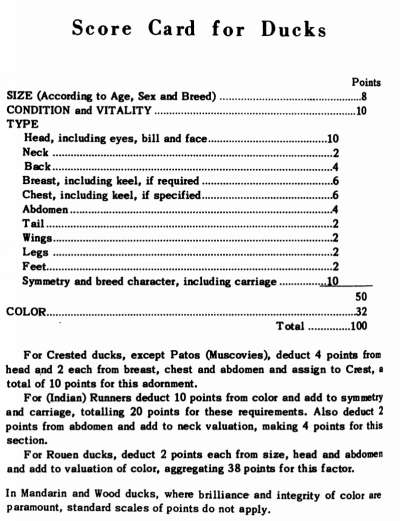Silver Appleyard
| Silver Appleyard | |||
|---|---|---|---|
| Origin | Category | Egg Colour | Sitter |
| Britain | Heavy Breed Duck | White to pale green | Yes |
The Silver Appleyard duck is a relatively new creation compared with some of the ancient breeds. It was created by Reginald Appleyard on his farm called “Priory Waterfowl Farm” at Ixworth in Suffolk in the 1930’s. His goal was to create a heavy breed that by 9 weeks old could produce a table bird of 3kg with a good meat to bone ratio that was also capable of laying a good number of large white eggs. In other words - a good dual-purpose duck.
After the Second World War, Silver Appleyard ducks became very rare. The poverty during war time resulted in the loss of many breeds. Birds were either eaten or the cost of keeping them was too high. Poultry numbers declined and the Silver Appleyard was one breed that that suffered. Tom Bartlett of Folly Farm in Gloucestershire kept 130 breeds of poultry for display to the public and he was instrumental in reviving the Appleyard during the late 1980’s.
The Silver Appleyard was imported into North America during the late 1960’s but remained quite rare for a couple of decades.
Silver Appleyard ducks were admitted to the British Poultry Standards in 1982, the American Standard of Perfection in 1998 and the Australian Poultry Standards in 1998.
GENERAL CHARACTERISTICS
Carriage in both male and female: Active, slightly elevated, the back sloping gradually from shoulder to rear.
Type: Broad and well rounded, of moderate length. Tail having a slight lift.
Head: oval. Bill: broad and of medium length. Eyes: bright and attentive.
Neck: strong, of medium length. Upright..
Legs and feet. medium in length, set slightly backwards of centre.
Plumage tight and smooth.
COLOUR
COLOUR MALE
The male Silver Appleyard has a head and neck of iridescent green, with faint eyebrow and cheek marks of silver/white. The throat has a silvery white flecked appearance. He has a full white ring encircling the neck. Below that ring the base of the neck down to the shoulders is a rich claret colour.
The breast is also the claret colour with each feather tipped by a fine white fringe. The claret bib front graduates to white which extends under the body.
The side flanks are of stippled grey pencilling on a white ground colour. The claret colour of the breast pushes along the upper portion of the flank above the thigh coverts which are light grey.
The back shades from the claret to a dark grey mottled pattern.
The rump is a solid greenish black, with the underneath of the tail black and the tail grey with broad white edging.
Wings: The primary feathers are grey and white with white edging. The secondaries or speculum is iridescent blue tipped with black followed by white. It is important that the speculum shows that iridescent blue. Tertials are grey. Tertials are grey and wing coverts match the lower breast and underbody. Scapulars are grey stipple with the outer edge being a chestnut colour.
Bill: yellow or yellow-green. Dark bean.
COLOUR FEMALE
In the female the head and neck is a silvery white, complemented by the top and back of the neck showing fawn flecked with brownish grey. The fawn colouring on the neck continues down to join the shoulder. There is a dark fawn line going through the eye.
Creamy white plumage encompass the breast and under the body. Down the flanks creamy white or fawn flecked with brown-grey extends. The back is a fawn colour flecked with brownish grey. The tail is a mottled fawn colour with each feather having a darker centre.
Primary wing feathers are creamy white with brown towards the end. The speculum is blue, tipped with black followed by white. The tertials are a mottled brownish fawn and coverts are white, marked with some greyish fawn. Scapulars are fawn with grey-brown streaks.
Bill: yellow with brown markings. Darker bean.
Both sexes: Eyes: dark hazel. Legs: orange.
WEIGHTS
Standard
Male 3.60-4.10 kg Female 3.20-3.60 kg
Bantam
Male 1.2-1.4 kg Female 1.1-1.3 kg
SCALE OF POINTS
Scale of points Carriage 10 Head, bill and neck IS Body 15 Legs and feet 5 Condition 10 Colour 30 Size 15 Total 100 Photo
SERIOUS DEFECTS
Lack of blue speculum.
Any keel.
Male: lack of cheek and throat markings.
Female: Brown head and neck, missing eye stripes.
SOURCES
- Ducks and geese by Great Britain. Ministry of Agriculture, Fisheries and Food. Publication date 1973 https://archive.org/details/ducksgeese0000grea/page/76/mode/2up
- Poultry Keeper website: https://poultrykeeper.com/duck-breeds/silver-appleyard-ducks/
- Australian Poultry Standards 2nd Edition
- British Poultry Standards 7th Edition


